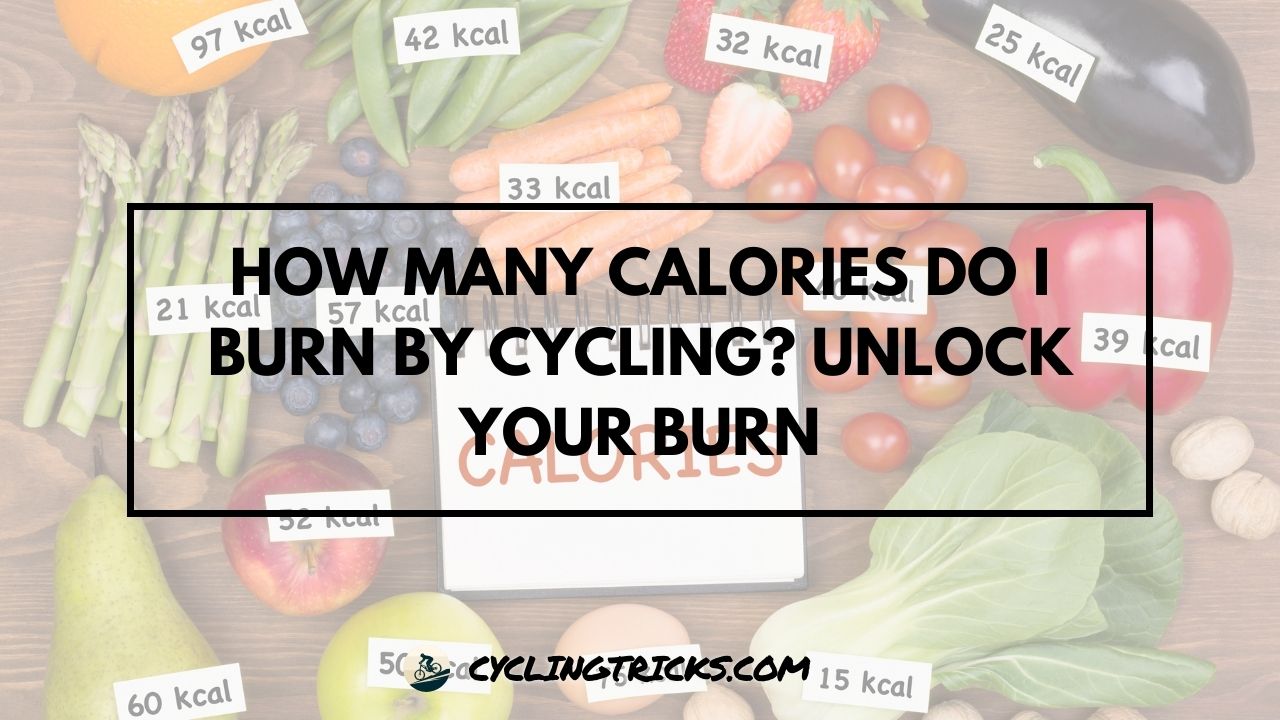Did you know that cycling can burn a significant amount of calories?
According to a study conducted by the American Council on Exercise, an average person can burn approximately 500-1000 calories per hour of cycling, depending on various factors.
Now, imagine the impact that consistent cycling can have on your calorie expenditure and fitness goals!
In this article, I will explore the question “How many calories do I burn by cycling?” We will delve into the factors that influence calorie burn during cycling and how you can maximize your cycling calorie burn for optimum results.
So, get ready to unlock your burn and discover the potential of cycling as a calorie-burning exercise!
Key Takeaways:
- On average, cycling can burn around 500-1000 calories per hour.
- Calorie burn during cycling is influenced by various factors.
- Understanding these factors can help you optimize your cycling calorie burn.
- Cycling can be an effective exercise for weight loss and overall fitness.
- By implementing advanced techniques and training methods, you can enhance your cycling calorie burn.
How Many Calories Do I Burn By Cycling?
The number of calories you burn cycling depends on several factors, like your weight, intensity, terrain, and duration. It can range from around 300 calories per hour for easy riding to 1,000+ for intense efforts.

Understanding Cycling Calorie Burn
When it comes to burning calories, cycling can be a highly effective exercise. But how exactly does cycling burn calories? Let’s delve deeper into the factors that influence calorie burn during cycling and how you can track your progress.
Factors Affecting Calorie Burn
Several factors can affect the number of calories burned while cycling. These include:
- Speed: Cycling at a higher speed requires more energy and can result in a higher calorie burn per hour.
- Distance: The longer you cycle, the more calories you can burn. Cycling for a greater distance can lead to a higher calorie expenditure.
- Intensity: Cycling with increased intensity, such as uphill climbs or interval training, can greatly enhance calorie burn.
Tracking Calorie Burn
If you’re curious about the number of calories you burn while cycling, you can use a cycling calorie counter to keep track. These specialized devices or apps can estimate the calories burned based on factors like your weight, duration of the ride, and intensity level. By monitoring your calorie burn, you can better understand your progress and make adjustments to your cycling routine as needed.
Remember, it’s important to consult with a healthcare professional or a certified trainer for personalized advice on your fitness goals and calorie burning targets.
Now that we’ve explored how cycling burns calories and how to track your progress, it’s time to dive into how cycling can contribute to weight loss.
In the next section, we’ll discuss how cycling can boost your calorie burn and provide effective strategies for reaching your weight loss goals.
Cycling for Weight Loss: Boost Your Calorie Burn
If weight loss is your goal, cycling can be a highly effective exercise. Not only does it burn calories, but it also offers a low-impact workout that is gentle on your joints. Cycling allows you to enjoy the great outdoors while working towards your weight loss goals.
When it comes to cycling for weight loss, the key is to create a calorie deficit. This means burning more calories than you consume. Cycling can help you achieve this by increasing your calorie burn and boosting your metabolism.
Calculating the calories burned during your cycling workouts can give you an idea of how much progress you’re making toward your weight loss goals.
There are various methods to estimate calorie expenditure, such as using fitness trackers or online calculators. These tools take into account factors like your weight, speed, and duration of the ride to provide a rough estimate of the calories burned.
To maximize your calorie burn during cycling, consider incorporating interval training into your workouts. Alternating between high-intensity bursts and recovery periods can help increase the intensity of your ride and burn more calories.
Additionally, including hilly terrain or resistance training can challenge your muscles and further enhance your calorie burn.
Tips for optimizing your cycling workouts for weight loss:
- Gradually increase the duration and intensity of your rides to continually challenge your body.
- Include regular rest days to allow your muscles to recover and prevent overtraining.
- Stay hydrated and fuel your body with a balanced diet to support your weight loss goals.
- Consider incorporating strength training exercises to build muscle and increase overall calorie burn.
- Find a cycling buddy or join a group to stay motivated and accountable.
Remember, consistency is key when it comes to both weight loss and cycling. Aim to incorporate cycling into your weekly routine and make it a habit. With time and dedication, you can achieve your weight loss goals while enjoying the many benefits that cycling has to offer.
| Speed (mph) | Weight (lbs) | Calories Burned per Hour |
|---|---|---|
| 10 | 150 | 281 |
| 12 | 150 | 352 |
| 14 | 150 | 422 |
| 16 | 150 | 493 |
| 18 | 150 | 563 |
Benefits of Cycling for Weight Loss
When it comes to losing weight, cycling can be an incredibly effective exercise. Not only does it help you burn calories, but it also offers a wide range of other benefits that contribute to weight loss and overall fitness.
Let’s dive into the advantages of cycling as a weight loss exercise and discover how it can transform your health and well-being.
1. Burning Calories
Cycling is a fantastic way to burn calories and shed unwanted pounds. Whether you’re cycling indoors on a stationary bike or hitting the road or trails outdoors, cycling engages multiple muscle groups, making it an excellent cardiovascular workout.
On average, cycling at a moderate pace can burn around 400-600 calories per hour, depending on various factors such as weight, intensity, and terrain.
2. Boosting Cardiovascular Health
Cycling is a low-impact aerobic exercise that provides a fantastic workout for your heart and lungs. Regular cycling improves cardiovascular endurance, strengthens your heart muscles, and lowers the risk of heart disease.
By cycling regularly, you can improve your overall cardiovascular health and support your weight loss journey.
3. Building Muscle
Cycling is not only an excellent cardio workout but also a great way to build strength and muscle tone. As you pedal, you engage your leg muscles, including your quadriceps, hamstrings, and calves.
Additionally, cycling also activates your core muscles, contributing to better posture and stability. By incorporating cycling into your fitness routine, you can build lean muscle mass while burning calories, helping you achieve a toned and sculpted physique.
4. Enhancing Fitness Level
Regular cycling helps improve your overall fitness level by increasing your endurance, stamina, and lung capacity. As you push yourself during cycling workouts, your body becomes more efficient at using oxygen, allowing you to go for longer rides and tackle more challenging terrains.
By consistently challenging yourself on the bike, you can improve your physical fitness and achieve better weight loss results.
5. Spicing Up Your Workouts
Cycling offers a versatility that can keep your workout routine exciting and engaging. You can explore different routes, ride with friends join cycling groups, and even participate in cycling events or races.
By incorporating variety into your cycling workouts, you can prevent boredom, stay motivated, and make weight loss a more enjoyable experience.
As you can see, cycling provides numerous benefits for weight loss. Not only does it help you burn calories and shed pounds, but it also improves cardiovascular health, builds muscle, and enhances your overall fitness level. If you’re looking for a fun and effective way to lose weight, cycling is definitely worth considering.
Enhancing Your Cycling Calorie Burn
Looking to take your cycling calorie burn to the next level?
You’re in luck! In this section, I’ll share some advanced techniques and training methods that can help you maximize calorie burn during your cycling workouts.
By incorporating these strategies into your routine, you’ll be able to achieve your fitness goals more efficiently and effectively.
1. Interval Training
Interval training involves alternating between periods of high-intensity cycling and lower-intensity active recovery. This method has been shown to significantly increase calorie burn during and after exercise, as well as improve cardiovascular fitness.
Tip: Try incorporating sprint intervals into your ride by pedaling at an all-out effort for 30 seconds, followed by 60 seconds of moderate-paced cycling. Repeat this cycle for a designated period of time, such as 10 minutes.
2. Vary Terrain and Resistance Levels
Changing up the terrain and resistance levels during your cycling workouts can provide new challenges for your muscles and boost calorie burn. If you usually stick to flat routes, try adding some hilly sections to your rides. The inclines will require more effort, resulting in increased calorie expenditure.
Tip: If you’re cycling indoors, make use of the resistance settings on your stationary bike or indoor cycling trainer. Increase the resistance to simulate riding uphill and challenge your muscles.
3. Other Factors That Impact Calories Burned
While speed, distance, and intensity are important factors in calorie burn during cycling, there are other variables to consider as well. These factors can impact the number of calories you burn:
- Body Weight: Heavier individuals tend to burn more calories during exercise.
- Efficiency: Improving your cycling technique and form can help you become more efficient, resulting in a higher calorie burn.
- Duration: Longer cycling sessions can lead to higher overall calorie expenditure.
- Weather Conditions: Cycling against the wind or in hot temperatures can increase the intensity of your ride, leading to more calories burned.
By keeping these factors in mind and incorporating the techniques mentioned above, you can enhance your cycling calorie burn and get the most out of your workouts.
| Activity | Average Calorie Burn per Hour (Based on 150 lb individual) |
|---|---|
| Leisurely Cycling (10-12 mph) | 292 |
| Moderate Cycling (12-14 mph) | 410 |
| Vigorous Cycling (14-16 mph) | 588 |
| Mountain Biking (rough terrain) | 584 |
Note: The calorie burn values provided above are approximate and can vary based on individual factors such as weight, fitness level, and cycling efficiency.
Now that you have a better understanding of how to enhance your cycling calorie burn, it’s time to put these strategies into action. Remember to listen to your body and gradually increase the intensity and duration of your workouts to avoid overexertion.
Conclusion
In conclusion, understanding how many calories you burn by cycling is vital for achieving your fitness and weight loss goals. By incorporating the information and strategies outlined in this guide, you can unlock your burn and make the most out of your cycling workouts to maximize calorie expenditure.
Remember, factors such as speed, distance, intensity, and terrain play a significant role in determining your calorie burn. Utilize a cycling calorie counter to track your progress and stay motivated.
Whether you are looking to shed pounds or improve your overall fitness, cycling can be a powerful tool. Take advantage of this low-impact and enjoyable exercise to boost your calorie burn, improve cardiovascular health, build muscle, and achieve the results you desire. So hop on your bike and start pedaling towards a healthier and fitter you today!









